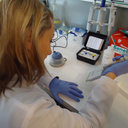Lysophosphatidic acid plasma concentrations in healthy subjects: circadian rhythm and associations with demographic, anthropometric and biochemical parameters.
Ključne besede
Povzetek
BACKGROUND
Lysophosphatidic acid (LPA) is a bioactive lipid with a wide biological activity. Previous studies have shown its potential usefulness as a diagnostic marker for ovarian cancer. The aim of the study was to investigate which factors may influence plasma LPA concentrations in healthy subjects and to propose reference values.
METHODS
The study group consisted of 100 healthy subjects. From all of them the blood samples were taken at 7 a.m. (fasting state). From 40 volunteers additional blood samples were taken at 2 p.m., at 8 p.m. and at 2 a.m. next morning. Concentrations of LPA were measured in plasma samples using enzyme-linked immunosorbent assay.
RESULTS
Analysis of samples from 100 healthy volunteers showed significant influence of sex and age on plasma LPA. The reference range for the plasma LPA concentration corrected for age and sex, determined at 2.5-97.5 percentile interval is 0.14-1.64 μM. LPA correlates positively with BMI, serum total cholesterol, triacylglycerols, uric acid and negatively with estimated glomerular filtration rate and serum albumin. Concentration of LPA at 2 a.m. was lower than at 2 p.m. There were not any significant differences between plasma LPA at 7 a.m. and any other time of the day.
CONCLUSIONS
Plasma LPA is associated with demographic, anthropometric and biochemical parameters. It seems that LPA concentrations have no specific circadian rhythm and the time of donation and fasting state have marginal effect on plasma LPA. These findings may be helpful in future incorporation of LPA as a diagnostic marker.


